Remembering MARK FIDRYCH – The Bird’s Lone Baltimore Appearance, 7/4/1977
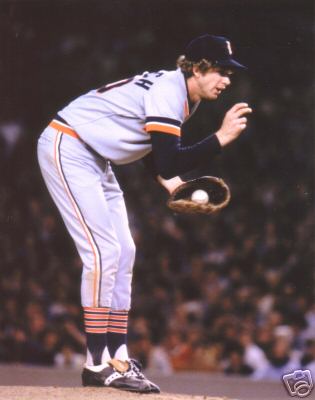
Mark "The Bird" Fidrych on the hill
The news of Mark Fidrych’s death hit me pretty hard. He pitched in the first major league baseball game I ever attended and –though I was only six-years-old– he made a lasting impression and deserves more than a little credit for turning me into a lifelong baseball fanatic. I never had the pleasure of meeting the 1976 AL Rookie-of-the-Year, but I mailed some things to him to be autographed over the years. He signed them and sent them back quickly without fail, and I was happy to receive a signed McCarthy postcard of “The Bird” less than a month ago. As a tribute to one of baseball’s all-time great characters, here’s an account of the night I saw him pitch, pieced together by my boyhood memories, indispensable websites like baseball-reference.com & retrosheet.org, and (mostly) newspaper accounts of that game penned by Tom Boswell, Dan Shaughnessy, Bill Tanton & Lou Hatter. Whether you’re a fan of Fidrych, the Baltimore Orioles or just the great game of baseball, I hope you’ll enjoy it.
On the Fourth of July, 1977 in Baltimore, Maryland, more people filed into Memorial Stadium than on any other Independence Day, and the hometown Orioles and post-game fireworks extravaganza were not the primary reasons why. That distinction belonged to the opposing starting pitcher, whose face was on the front of Sport magazine, and had already graced covers of Sports Illustrated and Rolling Stone since Opening Day. Mark “The Bird” Fidrych was about to make his first (and what proved to be only) local appearance, and an awful lot of people were determined not to miss it. “Will the fans in the right field bleachers please sit closer together so that more people can get in the ballpark?” pleaded PA announcer Rex Barney as game time drew closer.
If they were coming to see the 22-year-old, frizzy-haired, pop culture phenomenon in all his spontaeous glory, they may have already been too late. “You can already see that Fidrych is doing less of that stuff that the fans love,” observed Orioles manager Earl Weaver. “He says he saw himself on TV for the first time over the winter, and it probably embarrassed him some. He still talks to himself, but you don’t see him running around the infield as much, shaking everybody’s hand.”
Tigers veteran DH Rusty Staub agreed…to a point. “When the game gets tight, his concentration is so intense that he’s still liable to do anything,” remarked Le Grande Orange.
None of Fidrych’s antics would have attracted much attention at all if he hadn’t been such an effective pitcher, good enough to start the All-Star Game and led the league in Earned Run Average en route to Rookie-of-the-Year honors in 1976. After tearing cartilage in his left knee during spring training in 1977, “The Bird” missed six weeks and lost his first two outings after returning. He arrived in Baltimore riding a streak of six straight complete game victories, however, averaging less than one walk per game and pitching to a 1.33 ERA. In other words, he was back, and pitching better than ever.
The six o’clock, Monday night affair got underway with Detroit centerfielder Ron LeFlore grounding out to short against Orioles lefty Rudy May. Less than a year later, LeFlore –who served time for armed robbery before the Tigers discovered him in prison– would be played by LaVar Burton in a TV movie.
Each team stranded a runner after a first-inning single, but the Tigers drew first blood when right-fielder John Wockenfuss clubbed a 2-2 pitch for a solo home run just over Al Bumbry’s glove at the 385-foot sign in left-center an inning later. The right-hand-hitting Wockenfuss stood deeper in the batters’ box than the rules permitted, nearly stepped on home plate when he strode into the ball, and wiggled his fingers in anticipation when the pitcher went into his delivery. When I close my eyes, I can still see my Uncle Charlie imitating him.
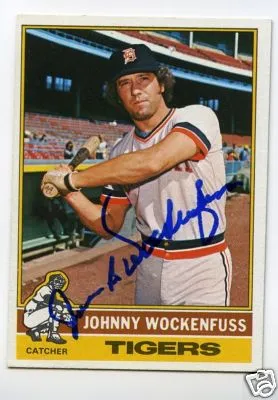
John Wockenfuss whacked a pair of dingers
Detroit’s lead increased to 2-0 in the third on a trio of consecutive singles. Tito Fuentes got it started with one-out safety to the right field corner. Ken Singleton corraled the ball quickly to prevent extra bases, but Fuentes scored after Staub and 1976 first-round pick Steve Kemp each knocked hits through the right side of the infield. With runners at first and third and only one out, Baltimore shortstop Mark Belanger’s long run into centerfield to make an over-the-shoulder grab of a blooper deserved every decibel of the loud ovation it inspired. Wockenfuss grounded out to end the threat, as May settled down to retire 15 of the next 16 Tigers hitters.
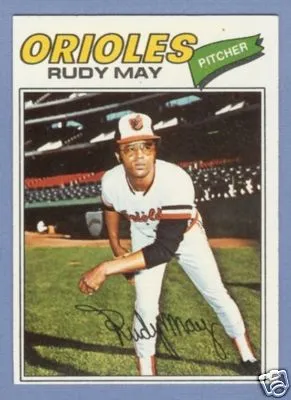
Southpaw Rudy May - the winning pitcher
The lead looked like more than enough for Fidrych. Despite putting the leadoff hitter on in each of the first two innings, he didn’t allow any Orioles as far as second base until the fourth. When Baltimore finally got their first baserunner in scoring position with two down, 1976 AL RBI leader Lee May struck out. The O’s got another man to second with two away in the fifth, but Fidrych escaped again by making Bumbry his second strikeout victim of the evening. Though Tigers manager Ralph Houk noticed his young ace was uncharacteristically getting a lot of pitches up in the strike zone, Fidrych described himself as “in the flow, in the groove, watchin’ ’em hit those sliders in the infield.”
“We killed all the worms around home plate for the first four or five innings,” Weaver agreed.
Nevertheless, “The Earl of Baltimore” encouraged his troops to go after Fidrych’s pitches early in the count and try to hit the ball to the opposite field. Meanwhile, the Tigers right-hander boogied on the mound as Fleetwood Mac’s “Dreams” played before the bottom of the sixth, then proceeded to record his 10th & 11th outs on ground balls to begin the inning. And then it happened. “Orioles Magic” wouldn’t come into the local vernacular for another two years, but there’s simply no other way to describe what happened next.
Baltimore right fielder Ken Singleton, who’d end up hitting a (then) club record .328 in 1977, fell behind no balls and two strikes before battling back to even the count. On what Fidrych called a “perfect pitch”, 2-2 fastball in on the hands, “Singy” fought it off and pushed it in to left for a base hit. On Fidrych’s very next pitch, a switch-hitting rookie named Eddie Murray took him deep. Fidrych punched the air with his fist as the ball sailed over the fence in left-center, his lead and his shutout bid disappearing into the night. Murray had been strictly a right-handed hitter until the previous year, but the clutch longball demonstrated his early mastery of a learning curve that would eventually lead him to the Hall of Fame.
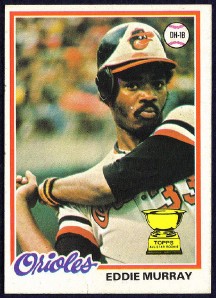
Eddie Murray - Rookie's blast tied the game
Lee May kept things going for the Orioles with a line drive double to the left-field fence, unnerving Fidrych, who stalked around the mound and audibly protested “What?!” when personal catcher Bruce Kimm signaled him to intentionally walk Doug DeCinces. After half the Tigers infield approached the mound to convince “The Bird” it was standard strategy with weak-hitting catcher Rick Dempsey due up next, Fidrych delivered a pitch that “The Dipper” lined into right to drive home the go-ahead run. Baltimore’s lead grew to 5-2 when Belanger dropped a pop fly double just fair into short right field with two strikes, driving Fidrych to scream obscenities in frustration. “When a team starts finding the holes, the other pitcher just has to start thinking,” Fidrych explained.
Fidrych would have plenty of time to do that. Al Bumbry grounded a single up the middle for the sixth straight Orioles hit (around the intentional walk), and Fidrych’s night was all over, his shortest outing of the season to that point. He got a rare standing ovation for a visiting player, and tipped his cap twice in response before firing his glove in frustration as he entered the first-base dugout (that drew boos). “You have to respect the fans, you have to show your gratitude,” said Fidrych after the game. “It was neat, but they came to see me get shelled and that’s what happened.”
Detroit closed the gap on solo homers Staub in the eighth, and another long ball by Wockenfuss off tiring Rudy May’s first pitch in the ninth. Southpaw reliever Tippy Martinez struck out the first man he faced, but the Tigers got the tying run to the plate after one-out single. With powerful pinch-hitter Ben Oglivie representing the tying run, the game ended with an exciting play that made Weaver rightfully look like a genius. Tony Muser had replaced Lee May at first base for defensive purposes, and he dove to spear Oglivie’s line drive, landing with half his body in foul territory. Muser then scrambled partially to his feet and slid headfirst into the first base bag to beat Detroit’s Milt May for the game’s final out on an unassisted double play.
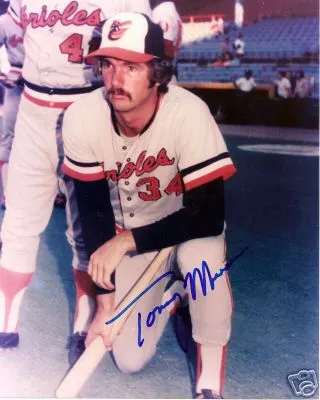
Tony Muser - what a play!
Final score: Orioles 6, Tigers 4. The whole thing took just an hour and 59 minutes!
“The Fourth of July was a bang…for Baltimore. I saw to that.” said Fidrych in the visiting clubhouse when it was through. “Things sure changed fast. To get six runs with two outs and nobody on. I’ll bet they don’t do that again all year.”
He was right about that, but missed the mark a bit when he said “They’re (fans) only gonna come as long as I win. If I wasn’t winning, I’d be just another player. They ain’t gonna drive no hour to see a guy who loses.”
Mark Fidrych lost to the White Sox four days later in Detroit. Four days after that he lasted only 15 pitches against the Blue Jays before exiting with a sore shoulder. He would win only four more major league games in just 16 starts the next three years before injuries ended his once bright big league career for good, but the fans never forgot him or stopped cheering for him…and they never will. Rest in peace, Mark.
by Malcolm Allen
malallen@live.com
Malcolm,
Great post on your part. I live in Gloucester City, NJ, and I drove by myself to old Memorial Stadium in Baltimore to see “The Bird”
pitch against the O’s on that July 4th. I still have the program and ticket stub (great mezzanine seat near 1st. base; $5.00!).
In retrospect, that 6th. inning (2 outs, 2 strikes!), was probably the turning point in his entire career.
If you want to see testimony of what a great man Mark was, google the local obit (e.g., in the Worcester paper), and check out the link to the funeral home and then click on the “Guest Book” to see the literally hundreds of comments posted each day, most of which include personal anecdotes of how Mark personally and positively impacted someone’s life.
All the best,
Billy
Bill Waters - April 17, 2009 at 4:31 am |
With the announcement of Mark Fidrych’s death I was recalling the times my late Dad and I went to see the Orioles play. We lived in Richmond, Virginia and made several trips to Baltimore. As a kid I do not remember them all – but I do remember from time-to-time my Dad would recount all of the stars we saw play, from Jim Palmer to Reggie Jackson, etc. I distinctly remember him saying we saw “The Bird”. So, I was doing internet research to see when that was when I discovered this site. Apparently, it had to be July 4, 1977 as that was his only appearance in Baltimore. When I saw the date I remember a long and hot family trip to Washington D.C. As part of the trip we went to see the Oriole’s play. As sad as I was to see Mark’s death it did re-kindle warm thoughts of a family trip long ago. RIP
Doug Burton - April 19, 2009 at 8:46 am |
I was at that game. Had a lady from Detroit behind us yelling “The Bird
will fly”. She was very quiet after the 6th inning.
As I recall they had Fireworks at the Stadium after the game. Best I ever saw, right over your heads.
Jack Lee - August 18, 2009 at 9:03 pm |